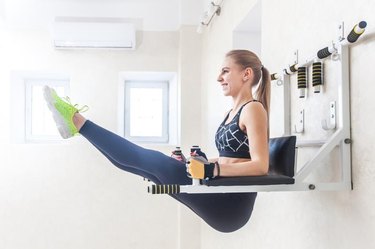
It's the million dollar question for fitness fanatics: What's the best ab exercise? In 2001, the American Council on Exercise (ACE) sponsored a study to try to answer that question, ranking 13 ab exercises by muscle activation. While bicycle crunches took the top spot, an outlier — the captain's chair — took second place.
Why focus on second place? Even though bicycle crunches produce the most muscle activity in the rectus abdominis (the six-pack part of your abs), the captain's chair (the piece of gym equipment that looks a bit like an armchair missing the seat) was top of the heap for strengthening your obliques (the muscles along the sides of your torso), and it involves more than just muscle activity.
Video of the Day
Video of the Day
"The best ab workouts combine two types of movements — flexion/extension and rotation — as well as a focus on mobility and stability," says Jonathan Ross, certified personal trainer and author of Abs Revealed. "Flexion/extension and rotation cover all of the movements of the spine, while stability and mobility cover the two types of actions capable for any body part."
Here's why experts think you should ditch crunches for a spin on the captain's chair.
The Problem With Crunches
Aside from not being a very functional exercise (when are you doing a repetitive crunching movement in your day-to-day life?), the biggest problem with crunches is they aren't for everyone.
This is especially true for people dealing with previous injuries or chronic lower back or neck pain, as improper form can only exacerbate your symptoms, says Nick DiSarro, DPT, a physical therapist with ResilientRx, based in Austin, Texas.
"If someone has pain, tingling or numbness that travels into their arms or legs that is worsened with spinal flexion (movements like bending over, crunches, sit-ups, etc.), they especially should refrain from crunches until those symptoms are resolved," he says.
DiSarro is quick to point out that crunches and sit-ups haven't been found to directly cause back pain, and if they do cause it, the pain is probably because your muscles, joints and nervous system isn't adequately prepared to handle the movement.
Read more: 3 Ab Exercises That Aren't Worth Your Time
Why the Captain’s Chair Is Better — and How to Master the Move
Because of the positioning of the captain's chair, the move is much easier on your body, especially for those who have back or neck pain. A big part of this is the upright position it puts our body in, Ross says, because it's similar to how you're naturally aligned in your daily life.
Plus, it's a better exercise for the hard-to-target lower portion of your abs. "While there's anatomically no distinction between upper and lower abs, functionally there is, as we can preferentially contract upper or lower sections with more force than the other region," he says. "The lower abdominals are typically weaker for many people, so the captain's chair can provide an opportunity to shore up a common area of weakness."
How to Do Hanging Knee Raises on the Captain's Chair
- Climb up into the chair with your back pressed against the backrest, arms and elbows on the armrests (to support your body weight), hands gripping the handles and legs extended straight down.
- From there, pull your knees up toward your chest, engaging your abdominal muscles in the process.
- To finish the move, extend your legs back to the starting position and repeat.
Tip
Keep your abdominal muscles engaged at the bottom of the movement so you don’t arch your back and swing your legs forward to get them up toward your chest, Ross says. You shouldn’t be relying on momentum.
For more a challenge, don't bend your knees. Instead lift your legs straight out in front of you.
At-Home Alternatives to the Captain's Chair
The downside of the captain's chair is that it can only be done in the gym (unless you have a super fancy home gym). But Ross says a series of leg raises, scissor kicks or toe touches — with the feet kept off of the floor for the entire exercise — can provide similar results.
Move 1: Leg Raises
- Lie on your back with your legs extended out straight and your hands under your lower back for support.
- Lift both legs off the floor until they are perpendicular to the ground.
- Lower back down with control, stopping just before your legs reach the floor.
Move 2: Scissor Kicks
- Lie on your back with your legs extended out straight and your hands under your lower back for support.
- Lift both legs a few inches off the floor.
- Raise one leg until it's at a 45-degree angle to the floor.
- Lower back down with control, stopping just before your leg reaches the floor. As you lower one leg, raise the other leg up to 45 degrees.
- Continue alternating legs with each kick.
Move 3: Toe Touches
- Lie on your back with your legs extended out straight and hold your arms straight out over your chest.
- Lift both legs off the floor until they're perpendicular to the ground and keep them there throughout the exercise.
- Use your abs to lift your head and upper back off the ground as you reach toward your toes. Don't collapse your chin to your chest.
- Lower back down so that your head hovers above the ground.